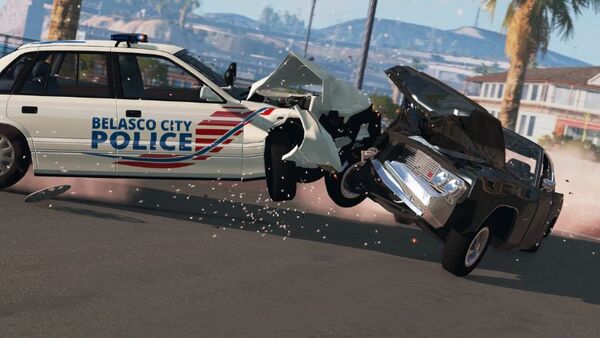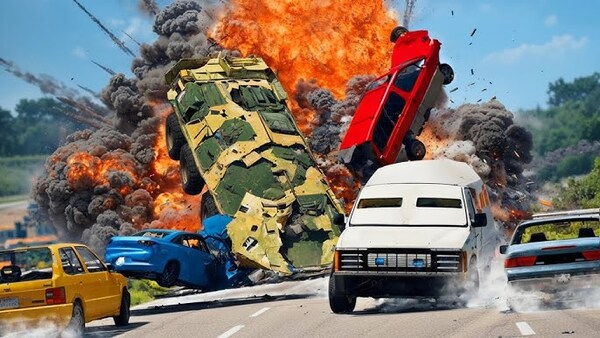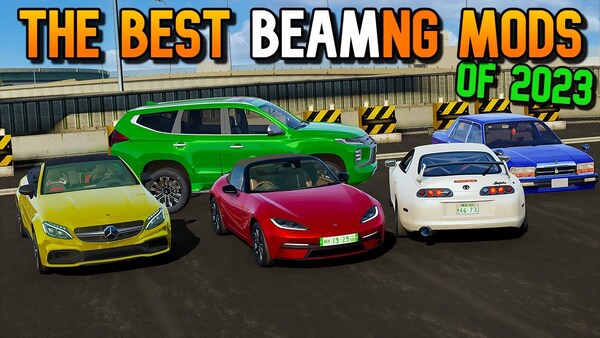Advertisement
Popular Now
Introduction
BeamNG.drive is a vehicle simulation game celebrated for its advanced physics engine, realistic crash dynamics, and meticulous vehicle handling. However, mastering these physics can be challenging, particularly when players attempt to navigate vehicle crashes and the diverse mechanics at play. This article explores in-depth how BeamNG’s crash physics operate, the dynamics of vehicle damage, and how to optimize gameplay to take full advantage of the game’s detailed simulation. From understanding how crashes impact vehicle parts to experimenting with custom settings, here’s a guide to mastering the intricacies of BeamNG.drive’s physics.
Understanding BeamNG.drive’s Soft-Body Physics
BeamNG.drive’s core appeal is its soft-body physics, which simulate real-world vehicle deformations during crashes. Let’s look into how this system functions.
[caption id="attachment_1294" align="aligncenter" width="600"] BeamNG.drive’s core appeal is its soft-body physics, which simulate real-world vehicle deformations during crashes.[/caption]
How Soft-Body Physics Work
Soft-body physics replicate how materials respond under stress, enabling the game to simulate realistic bending, crushing, and deforming in a way that feels true to life.
Importance in Crash Simulation
Unlike hard-body physics in other games, which treat vehicles as unchanging, BeamNG’s physics allow for dynamic, responsive changes that depend on impact force, speed, and angle.
Breaking Down Vehicle Components in Crashes
Each vehicle in BeamNG.drive is composed of various parts, each behaving differently upon impact. Understanding these components helps in predicting and controlling crash outcomes.
Frames and Chassis Damage
The frame or chassis is the vehicle’s backbone, and any damage here impacts overall stability. Players can observe how chassis damage affects control and handling post-collision.
Engine and Transmission Vulnerabilities
Crashes can severely impact the engine and transmission. Learning to recognize signs of engine failure or transmission damage can aid in vehicle recovery techniques.
Analyzing the Effects of Speed on Crash Dynamics
Speed is a major factor in determining the severity of crashes. Here, we’ll examine how BeamNG.drive interprets different crash speeds and their effects on the vehicle.
Low-Speed Impacts
Low-speed collisions may cause minimal visual damage, but structural damage can still impair performance, requiring careful driving post-collision.
High-Speed Collisions
At high speeds, crashes produce dramatic results with extensive deformation, leaving the vehicle often unusable. High-speed crashes emphasize BeamNG’s detailed physics, showcasing fragmentation and part detachment.
Experimenting with Collision Angles and Impact Zones
The angle and area of impact influence the extent of vehicle damage. Knowing how to vary impact zones can provide insight into minimizing or maximizing crash effects.
Front and Rear Impacts
Front-end crashes often result in engine and radiator damage, while rear-end collisions may impact the trunk and fuel system, both requiring unique recovery strategies.
Side-Impact Collisions
Side impacts pose a high risk to structural integrity. Practicing different angles helps players understand how to control the vehicle’s trajectory post-impact.
Exploring Deformation Sensitivity Across Different Vehicles
Each vehicle in BeamNG.drive has unique crash dynamics. By experimenting with different models, players can learn which vehicles are more resilient and which are prone to extensive damage.
Heavy vs. Light Vehicles
Heavy trucks and SUVs often withstand crashes better than lighter sports cars, whose frames crumple more dramatically due to their weight distribution and material composition.
Realistic Vehicle Deformation
The game’s attention to detail means that every vehicle reacts differently based on its design, giving players a highly customizable crash experience.
Enhancing Crash Realism Through Game Settings
BeamNG.drive allows players to adjust various game settings to tailor the realism of crashes. Here, we’ll explore which settings impact crash fidelity and how to adjust them.
Adjusting Physics Quality
Increasing physics quality makes crashes more detailed but requires a powerful computer. Lowering these settings can reduce realism but boost performance.
Setting Vehicle Stability Assistance
Vehicle stability settings help control the vehicle after a crash, assisting in recovering from spins or maintaining post-collision stability.
[caption id="attachment_1295" align="aligncenter" width="600"]
BeamNG.drive’s core appeal is its soft-body physics, which simulate real-world vehicle deformations during crashes.[/caption]
How Soft-Body Physics Work
Soft-body physics replicate how materials respond under stress, enabling the game to simulate realistic bending, crushing, and deforming in a way that feels true to life.
Importance in Crash Simulation
Unlike hard-body physics in other games, which treat vehicles as unchanging, BeamNG’s physics allow for dynamic, responsive changes that depend on impact force, speed, and angle.
Breaking Down Vehicle Components in Crashes
Each vehicle in BeamNG.drive is composed of various parts, each behaving differently upon impact. Understanding these components helps in predicting and controlling crash outcomes.
Frames and Chassis Damage
The frame or chassis is the vehicle’s backbone, and any damage here impacts overall stability. Players can observe how chassis damage affects control and handling post-collision.
Engine and Transmission Vulnerabilities
Crashes can severely impact the engine and transmission. Learning to recognize signs of engine failure or transmission damage can aid in vehicle recovery techniques.
Analyzing the Effects of Speed on Crash Dynamics
Speed is a major factor in determining the severity of crashes. Here, we’ll examine how BeamNG.drive interprets different crash speeds and their effects on the vehicle.
Low-Speed Impacts
Low-speed collisions may cause minimal visual damage, but structural damage can still impair performance, requiring careful driving post-collision.
High-Speed Collisions
At high speeds, crashes produce dramatic results with extensive deformation, leaving the vehicle often unusable. High-speed crashes emphasize BeamNG’s detailed physics, showcasing fragmentation and part detachment.
Experimenting with Collision Angles and Impact Zones
The angle and area of impact influence the extent of vehicle damage. Knowing how to vary impact zones can provide insight into minimizing or maximizing crash effects.
Front and Rear Impacts
Front-end crashes often result in engine and radiator damage, while rear-end collisions may impact the trunk and fuel system, both requiring unique recovery strategies.
Side-Impact Collisions
Side impacts pose a high risk to structural integrity. Practicing different angles helps players understand how to control the vehicle’s trajectory post-impact.
Exploring Deformation Sensitivity Across Different Vehicles
Each vehicle in BeamNG.drive has unique crash dynamics. By experimenting with different models, players can learn which vehicles are more resilient and which are prone to extensive damage.
Heavy vs. Light Vehicles
Heavy trucks and SUVs often withstand crashes better than lighter sports cars, whose frames crumple more dramatically due to their weight distribution and material composition.
Realistic Vehicle Deformation
The game’s attention to detail means that every vehicle reacts differently based on its design, giving players a highly customizable crash experience.
Enhancing Crash Realism Through Game Settings
BeamNG.drive allows players to adjust various game settings to tailor the realism of crashes. Here, we’ll explore which settings impact crash fidelity and how to adjust them.
Adjusting Physics Quality
Increasing physics quality makes crashes more detailed but requires a powerful computer. Lowering these settings can reduce realism but boost performance.
Setting Vehicle Stability Assistance
Vehicle stability settings help control the vehicle after a crash, assisting in recovering from spins or maintaining post-collision stability.
[caption id="attachment_1295" align="aligncenter" width="600"] Vehicle stability settings help control the vehicle after a crash, assisting in recovering from spins or maintaining post-collision stability[/caption]
Understanding Tire and Suspension Reactions to Impacts
BeamNG.drive pays close attention to tire and suspension mechanics. Knowing how crashes affect these parts is essential for advanced crash recovery.
Suspension Compression and Breakage
Upon impact, suspension components may compress or break, drastically altering handling. Observing these reactions aids in understanding the limits of each vehicle.
Tire Punctures and Blowouts
Crashes often result in punctured tires or blowouts, impacting grip and control. Practicing tire management post-crash enhances overall maneuverability.
Using Crash Scenarios to Practice Vehicle Recovery
BeamNG.drive’s crash scenarios allow players to test their recovery skills. Practicing these can teach players effective crash handling techniques.
Controlled Crash Scenarios
Controlled scenarios simulate specific crash conditions, letting players observe how certain impacts affect different parts of the vehicle.
Randomized Crash Testing
Random scenarios test player adaptability by creating unexpected crash situations, challenging them to apply recovery techniques on the spot.
Modifying Vehicle Parts for Customized Crash Results
The game enables players to modify vehicles, adjusting parts like engines, tires, and frames to alter crash dynamics. Let’s explore how custom modifications affect crashes.
Strengthening Frames and Reinforcements
Adding reinforcements makes vehicles more crash-resistant, allowing players to experiment with higher-speed impacts safely.
Upgrading Tires and Brakes
High-performance tires and brakes offer better crash control and recovery, giving players an advantage in high-stakes crashes.
Interpreting Crash Data in Replay Mode for Analysis
BeamNG.drive includes a replay mode that allows players to review crashes in detail. This feature is invaluable for understanding crash dynamics and improving skills.
Identifying Impact Points
Replay mode enables players to pinpoint exactly where impacts occur, allowing for a detailed analysis of crash causation.
Improving Crash Techniques Through Review
Using replay insights, players can modify their driving or crash handling techniques for better performance in future crashes.
Conclusion
Mastering BeamNG.drive’s crash physics requires a deep understanding of vehicle dynamics, game settings, and recovery techniques. By experimenting with collision angles, modifying vehicles, and analyzing crashes through replay mode, players can maximize their experience and enjoy the unique, realistic challenges BeamNG.drive offers. Whether you’re practicing controlled scenarios or testing new mods, these tips provide a solid foundation for navigating BeamNG’s sophisticated crash system.
Vehicle stability settings help control the vehicle after a crash, assisting in recovering from spins or maintaining post-collision stability[/caption]
Understanding Tire and Suspension Reactions to Impacts
BeamNG.drive pays close attention to tire and suspension mechanics. Knowing how crashes affect these parts is essential for advanced crash recovery.
Suspension Compression and Breakage
Upon impact, suspension components may compress or break, drastically altering handling. Observing these reactions aids in understanding the limits of each vehicle.
Tire Punctures and Blowouts
Crashes often result in punctured tires or blowouts, impacting grip and control. Practicing tire management post-crash enhances overall maneuverability.
Using Crash Scenarios to Practice Vehicle Recovery
BeamNG.drive’s crash scenarios allow players to test their recovery skills. Practicing these can teach players effective crash handling techniques.
Controlled Crash Scenarios
Controlled scenarios simulate specific crash conditions, letting players observe how certain impacts affect different parts of the vehicle.
Randomized Crash Testing
Random scenarios test player adaptability by creating unexpected crash situations, challenging them to apply recovery techniques on the spot.
Modifying Vehicle Parts for Customized Crash Results
The game enables players to modify vehicles, adjusting parts like engines, tires, and frames to alter crash dynamics. Let’s explore how custom modifications affect crashes.
Strengthening Frames and Reinforcements
Adding reinforcements makes vehicles more crash-resistant, allowing players to experiment with higher-speed impacts safely.
Upgrading Tires and Brakes
High-performance tires and brakes offer better crash control and recovery, giving players an advantage in high-stakes crashes.
Interpreting Crash Data in Replay Mode for Analysis
BeamNG.drive includes a replay mode that allows players to review crashes in detail. This feature is invaluable for understanding crash dynamics and improving skills.
Identifying Impact Points
Replay mode enables players to pinpoint exactly where impacts occur, allowing for a detailed analysis of crash causation.
Improving Crash Techniques Through Review
Using replay insights, players can modify their driving or crash handling techniques for better performance in future crashes.
Conclusion
Mastering BeamNG.drive’s crash physics requires a deep understanding of vehicle dynamics, game settings, and recovery techniques. By experimenting with collision angles, modifying vehicles, and analyzing crashes through replay mode, players can maximize their experience and enjoy the unique, realistic challenges BeamNG.drive offers. Whether you’re practicing controlled scenarios or testing new mods, these tips provide a solid foundation for navigating BeamNG’s sophisticated crash system.
 BeamNG.drive’s core appeal is its soft-body physics, which simulate real-world vehicle deformations during crashes.[/caption]
How Soft-Body Physics Work
Soft-body physics replicate how materials respond under stress, enabling the game to simulate realistic bending, crushing, and deforming in a way that feels true to life.
Importance in Crash Simulation
Unlike hard-body physics in other games, which treat vehicles as unchanging, BeamNG’s physics allow for dynamic, responsive changes that depend on impact force, speed, and angle.
Breaking Down Vehicle Components in Crashes
Each vehicle in BeamNG.drive is composed of various parts, each behaving differently upon impact. Understanding these components helps in predicting and controlling crash outcomes.
Frames and Chassis Damage
The frame or chassis is the vehicle’s backbone, and any damage here impacts overall stability. Players can observe how chassis damage affects control and handling post-collision.
Engine and Transmission Vulnerabilities
Crashes can severely impact the engine and transmission. Learning to recognize signs of engine failure or transmission damage can aid in vehicle recovery techniques.
Analyzing the Effects of Speed on Crash Dynamics
Speed is a major factor in determining the severity of crashes. Here, we’ll examine how BeamNG.drive interprets different crash speeds and their effects on the vehicle.
Low-Speed Impacts
Low-speed collisions may cause minimal visual damage, but structural damage can still impair performance, requiring careful driving post-collision.
High-Speed Collisions
At high speeds, crashes produce dramatic results with extensive deformation, leaving the vehicle often unusable. High-speed crashes emphasize BeamNG’s detailed physics, showcasing fragmentation and part detachment.
Experimenting with Collision Angles and Impact Zones
The angle and area of impact influence the extent of vehicle damage. Knowing how to vary impact zones can provide insight into minimizing or maximizing crash effects.
Front and Rear Impacts
Front-end crashes often result in engine and radiator damage, while rear-end collisions may impact the trunk and fuel system, both requiring unique recovery strategies.
Side-Impact Collisions
Side impacts pose a high risk to structural integrity. Practicing different angles helps players understand how to control the vehicle’s trajectory post-impact.
Exploring Deformation Sensitivity Across Different Vehicles
Each vehicle in BeamNG.drive has unique crash dynamics. By experimenting with different models, players can learn which vehicles are more resilient and which are prone to extensive damage.
Heavy vs. Light Vehicles
Heavy trucks and SUVs often withstand crashes better than lighter sports cars, whose frames crumple more dramatically due to their weight distribution and material composition.
Realistic Vehicle Deformation
The game’s attention to detail means that every vehicle reacts differently based on its design, giving players a highly customizable crash experience.
Enhancing Crash Realism Through Game Settings
BeamNG.drive allows players to adjust various game settings to tailor the realism of crashes. Here, we’ll explore which settings impact crash fidelity and how to adjust them.
Adjusting Physics Quality
Increasing physics quality makes crashes more detailed but requires a powerful computer. Lowering these settings can reduce realism but boost performance.
Setting Vehicle Stability Assistance
Vehicle stability settings help control the vehicle after a crash, assisting in recovering from spins or maintaining post-collision stability.
[caption id="attachment_1295" align="aligncenter" width="600"]
BeamNG.drive’s core appeal is its soft-body physics, which simulate real-world vehicle deformations during crashes.[/caption]
How Soft-Body Physics Work
Soft-body physics replicate how materials respond under stress, enabling the game to simulate realistic bending, crushing, and deforming in a way that feels true to life.
Importance in Crash Simulation
Unlike hard-body physics in other games, which treat vehicles as unchanging, BeamNG’s physics allow for dynamic, responsive changes that depend on impact force, speed, and angle.
Breaking Down Vehicle Components in Crashes
Each vehicle in BeamNG.drive is composed of various parts, each behaving differently upon impact. Understanding these components helps in predicting and controlling crash outcomes.
Frames and Chassis Damage
The frame or chassis is the vehicle’s backbone, and any damage here impacts overall stability. Players can observe how chassis damage affects control and handling post-collision.
Engine and Transmission Vulnerabilities
Crashes can severely impact the engine and transmission. Learning to recognize signs of engine failure or transmission damage can aid in vehicle recovery techniques.
Analyzing the Effects of Speed on Crash Dynamics
Speed is a major factor in determining the severity of crashes. Here, we’ll examine how BeamNG.drive interprets different crash speeds and their effects on the vehicle.
Low-Speed Impacts
Low-speed collisions may cause minimal visual damage, but structural damage can still impair performance, requiring careful driving post-collision.
High-Speed Collisions
At high speeds, crashes produce dramatic results with extensive deformation, leaving the vehicle often unusable. High-speed crashes emphasize BeamNG’s detailed physics, showcasing fragmentation and part detachment.
Experimenting with Collision Angles and Impact Zones
The angle and area of impact influence the extent of vehicle damage. Knowing how to vary impact zones can provide insight into minimizing or maximizing crash effects.
Front and Rear Impacts
Front-end crashes often result in engine and radiator damage, while rear-end collisions may impact the trunk and fuel system, both requiring unique recovery strategies.
Side-Impact Collisions
Side impacts pose a high risk to structural integrity. Practicing different angles helps players understand how to control the vehicle’s trajectory post-impact.
Exploring Deformation Sensitivity Across Different Vehicles
Each vehicle in BeamNG.drive has unique crash dynamics. By experimenting with different models, players can learn which vehicles are more resilient and which are prone to extensive damage.
Heavy vs. Light Vehicles
Heavy trucks and SUVs often withstand crashes better than lighter sports cars, whose frames crumple more dramatically due to their weight distribution and material composition.
Realistic Vehicle Deformation
The game’s attention to detail means that every vehicle reacts differently based on its design, giving players a highly customizable crash experience.
Enhancing Crash Realism Through Game Settings
BeamNG.drive allows players to adjust various game settings to tailor the realism of crashes. Here, we’ll explore which settings impact crash fidelity and how to adjust them.
Adjusting Physics Quality
Increasing physics quality makes crashes more detailed but requires a powerful computer. Lowering these settings can reduce realism but boost performance.
Setting Vehicle Stability Assistance
Vehicle stability settings help control the vehicle after a crash, assisting in recovering from spins or maintaining post-collision stability.
[caption id="attachment_1295" align="aligncenter" width="600"] Vehicle stability settings help control the vehicle after a crash, assisting in recovering from spins or maintaining post-collision stability[/caption]
Understanding Tire and Suspension Reactions to Impacts
BeamNG.drive pays close attention to tire and suspension mechanics. Knowing how crashes affect these parts is essential for advanced crash recovery.
Suspension Compression and Breakage
Upon impact, suspension components may compress or break, drastically altering handling. Observing these reactions aids in understanding the limits of each vehicle.
Tire Punctures and Blowouts
Crashes often result in punctured tires or blowouts, impacting grip and control. Practicing tire management post-crash enhances overall maneuverability.
Using Crash Scenarios to Practice Vehicle Recovery
BeamNG.drive’s crash scenarios allow players to test their recovery skills. Practicing these can teach players effective crash handling techniques.
Controlled Crash Scenarios
Controlled scenarios simulate specific crash conditions, letting players observe how certain impacts affect different parts of the vehicle.
Randomized Crash Testing
Random scenarios test player adaptability by creating unexpected crash situations, challenging them to apply recovery techniques on the spot.
Modifying Vehicle Parts for Customized Crash Results
The game enables players to modify vehicles, adjusting parts like engines, tires, and frames to alter crash dynamics. Let’s explore how custom modifications affect crashes.
Strengthening Frames and Reinforcements
Adding reinforcements makes vehicles more crash-resistant, allowing players to experiment with higher-speed impacts safely.
Upgrading Tires and Brakes
High-performance tires and brakes offer better crash control and recovery, giving players an advantage in high-stakes crashes.
Interpreting Crash Data in Replay Mode for Analysis
BeamNG.drive includes a replay mode that allows players to review crashes in detail. This feature is invaluable for understanding crash dynamics and improving skills.
Identifying Impact Points
Replay mode enables players to pinpoint exactly where impacts occur, allowing for a detailed analysis of crash causation.
Improving Crash Techniques Through Review
Using replay insights, players can modify their driving or crash handling techniques for better performance in future crashes.
Conclusion
Mastering BeamNG.drive’s crash physics requires a deep understanding of vehicle dynamics, game settings, and recovery techniques. By experimenting with collision angles, modifying vehicles, and analyzing crashes through replay mode, players can maximize their experience and enjoy the unique, realistic challenges BeamNG.drive offers. Whether you’re practicing controlled scenarios or testing new mods, these tips provide a solid foundation for navigating BeamNG’s sophisticated crash system.
Vehicle stability settings help control the vehicle after a crash, assisting in recovering from spins or maintaining post-collision stability[/caption]
Understanding Tire and Suspension Reactions to Impacts
BeamNG.drive pays close attention to tire and suspension mechanics. Knowing how crashes affect these parts is essential for advanced crash recovery.
Suspension Compression and Breakage
Upon impact, suspension components may compress or break, drastically altering handling. Observing these reactions aids in understanding the limits of each vehicle.
Tire Punctures and Blowouts
Crashes often result in punctured tires or blowouts, impacting grip and control. Practicing tire management post-crash enhances overall maneuverability.
Using Crash Scenarios to Practice Vehicle Recovery
BeamNG.drive’s crash scenarios allow players to test their recovery skills. Practicing these can teach players effective crash handling techniques.
Controlled Crash Scenarios
Controlled scenarios simulate specific crash conditions, letting players observe how certain impacts affect different parts of the vehicle.
Randomized Crash Testing
Random scenarios test player adaptability by creating unexpected crash situations, challenging them to apply recovery techniques on the spot.
Modifying Vehicle Parts for Customized Crash Results
The game enables players to modify vehicles, adjusting parts like engines, tires, and frames to alter crash dynamics. Let’s explore how custom modifications affect crashes.
Strengthening Frames and Reinforcements
Adding reinforcements makes vehicles more crash-resistant, allowing players to experiment with higher-speed impacts safely.
Upgrading Tires and Brakes
High-performance tires and brakes offer better crash control and recovery, giving players an advantage in high-stakes crashes.
Interpreting Crash Data in Replay Mode for Analysis
BeamNG.drive includes a replay mode that allows players to review crashes in detail. This feature is invaluable for understanding crash dynamics and improving skills.
Identifying Impact Points
Replay mode enables players to pinpoint exactly where impacts occur, allowing for a detailed analysis of crash causation.
Improving Crash Techniques Through Review
Using replay insights, players can modify their driving or crash handling techniques for better performance in future crashes.
Conclusion
Mastering BeamNG.drive’s crash physics requires a deep understanding of vehicle dynamics, game settings, and recovery techniques. By experimenting with collision angles, modifying vehicles, and analyzing crashes through replay mode, players can maximize their experience and enjoy the unique, realistic challenges BeamNG.drive offers. Whether you’re practicing controlled scenarios or testing new mods, these tips provide a solid foundation for navigating BeamNG’s sophisticated crash system. 













